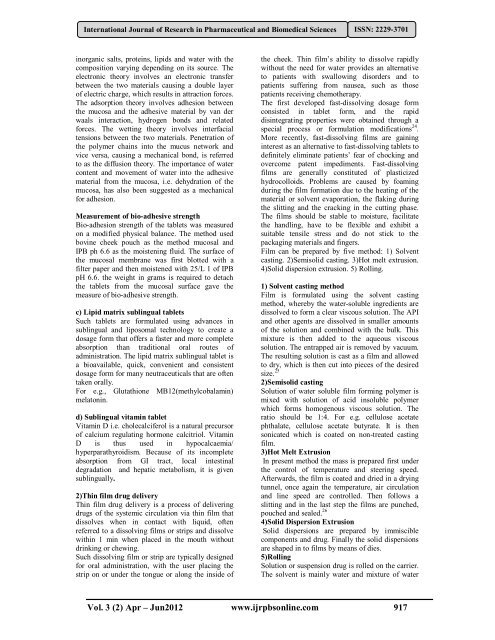An Overview on: Sublingual Route for Systemic Drug Delivery
An Overview on: Sublingual Route for Systemic Drug Delivery
An Overview on: Sublingual Route for Systemic Drug Delivery
Create successful ePaper yourself
Turn your PDF publications into a flip-book with our unique Google optimized e-Paper software.
Internati<strong>on</strong>al Journal of Research in Pharmaceutical and Biomedical Sciences ISSN: 2229-3701inorganic salts, proteins, lipids and water with thecompositi<strong>on</strong> varying depending <strong>on</strong> its source. Theelectr<strong>on</strong>ic theory involves an electr<strong>on</strong>ic transferbetween the two materials causing a double layerof electric charge, which results in attracti<strong>on</strong> <strong>for</strong>ces.The adsorpti<strong>on</strong> theory involves adhesi<strong>on</strong> betweenthe mucosa and the adhesive material by van derwaals interacti<strong>on</strong>, hydrogen b<strong>on</strong>ds and related<strong>for</strong>ces. The wetting theory involves interfacialtensi<strong>on</strong>s between the two materials. Penetrati<strong>on</strong> ofthe polymer chains into the mucus network andvice versa, causing a mechanical b<strong>on</strong>d, is referredto as the diffusi<strong>on</strong> theory. The importance of waterc<strong>on</strong>tent and movement of water into the adhesivematerial from the mucosa, i.e. dehydrati<strong>on</strong> of themucosa, has also been suggested as a mechanical<strong>for</strong> adhesi<strong>on</strong>.Measurement of bio-adhesive strengthBio-adhesi<strong>on</strong> strength of the tablets was measured<strong>on</strong> a modified physical balance. The method usedbovine cheek pouch as the method mucosal andIPB ph 6.6 as the moistening fluid. The surface ofthe mucosal membrane was first blotted with afilter paper and then moistened with 25/L 1 of IPBpH 6.6. the weight in grams is required to detachthe tablets from the mucosal surface gave themeasure of bio-adhesive strength.c) Lipid matrix sublingual tabletsSuch tablets are <strong>for</strong>mulated using advances insublingual and liposomal technology to create adosage <strong>for</strong>m that offers a faster and more completeabsorpti<strong>on</strong> than traditi<strong>on</strong>al oral routes ofadministrati<strong>on</strong>. The lipid matrix sublingual tablet isa bioavailable, quick, c<strong>on</strong>venient and c<strong>on</strong>sistentdosage <strong>for</strong>m <strong>for</strong> many neutraceuticals that are oftentaken orally.For e.g., Glutathi<strong>on</strong>e MB12(methylcobalamin)melat<strong>on</strong>in.d) <strong>Sublingual</strong> vitamin tabletVitamin D i.e. cholecalciferol is a natural precursorof calcium regulating horm<strong>on</strong>e calcitriol. VitaminD is thus used in hypocalcaemia/hyperparathyroidism. Because of its incompleteabsorpti<strong>on</strong> from GI tract, local intestinaldegradati<strong>on</strong> and hepatic metabolism, it is givensublingually.2)Thin film drug deliveryThin film drug delivery is a process of deliveringdrugs of the systemic circulati<strong>on</strong> via thin film thatdissolves when in c<strong>on</strong>tact with liquid, oftenreferred to a dissolving films or strips and dissolvewithin 1 min when placed in the mouth withoutdrinking or chewing.Such dissolving film or strip are typically designed<strong>for</strong> oral administrati<strong>on</strong>, with the user placing thestrip <strong>on</strong> or under the t<strong>on</strong>gue or al<strong>on</strong>g the inside ofthe cheek. Thin film’s ability to dissolve rapidlywithout the need <strong>for</strong> water provides an alternativeto patients with swallowing disorders and topatients suffering from nausea, such as thosepatients receiving chemotherapy.The first developed fast-dissolving dosage <strong>for</strong>mc<strong>on</strong>sisted in tablet <strong>for</strong>m, and the rapiddisintegrating properties were obtained through aspecial process or <strong>for</strong>mulati<strong>on</strong> modificati<strong>on</strong>s 24 .More recently, fast-dissolving films are gaininginterest as an alternative to fast-dissolving tablets todefinitely eliminate patients’ fear of chocking andovercome patent impediments. Fast-dissolvingfilms are generally c<strong>on</strong>stituted of plasticizedhydrocolloids. Problems are caused by foamingduring the film <strong>for</strong>mati<strong>on</strong> due to the heating of thematerial or solvent evaporati<strong>on</strong>, the flaking duringthe slitting and the cracking in the cutting phase.The films should be stable to moisture, facilitatethe handling, have to be flexible and exhibit asuitable tensile stress and do not stick to thepackaging materials and fingers.Film can be prepared by five method: 1) Solventcasting. 2)Semisolid casting. 3)Hot melt extrusi<strong>on</strong>.4)Solid dispersi<strong>on</strong> extrusi<strong>on</strong>. 5) Rolling.1) Solvent casting methodFilm is <strong>for</strong>mulated using the solvent castingmethod, whereby the water-soluble ingredients aredissolved to <strong>for</strong>m a clear viscous soluti<strong>on</strong>. The APIand other agents are dissolved in smaller amountsof the soluti<strong>on</strong> and combined with the bulk. Thismixture is then added to the aqueous viscoussoluti<strong>on</strong>. The entrapped air is removed by vacuum.The resulting soluti<strong>on</strong> is cast as a film and allowedto dry, which is then cut into pieces of the desiredsize. 252)Semisolid castingSoluti<strong>on</strong> of water soluble film <strong>for</strong>ming polymer ismixed with soluti<strong>on</strong> of acid insoluble polymerwhich <strong>for</strong>ms homogenous viscous soluti<strong>on</strong>. Theratio should be 1:4. For e.g. cellulose acetatephthalate, cellulose acetate butyrate. It is thens<strong>on</strong>icated which is coated <strong>on</strong> n<strong>on</strong>-treated castingfilm.3)Hot Melt Extrusi<strong>on</strong>In present method the mass is prepared first underthe c<strong>on</strong>trol of temperature and steering speed.Afterwards, the film is coated and dried in a dryingtunnel, <strong>on</strong>ce again the temperature, air circulati<strong>on</strong>and line speed are c<strong>on</strong>trolled. Then follows aslitting and in the last step the films are punched,pouched and sealed. 264)Solid Dispersi<strong>on</strong> Extrusi<strong>on</strong>Solid dispersi<strong>on</strong>s are prepared by immisciblecomp<strong>on</strong>ents and drug. Finally the solid dispersi<strong>on</strong>sare shaped in to films by means of dies.5)RollingSoluti<strong>on</strong> or suspensi<strong>on</strong> drug is rolled <strong>on</strong> the carrier.The solvent is mainly water and mixture of waterVol. 3 (2) Apr – Jun2012 www.ijrpbs<strong>on</strong>line.com 917
















